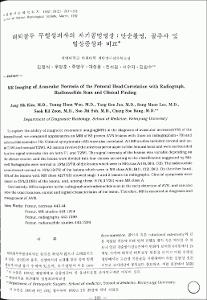대퇴골두 무혈성괴사의 자기공명영상: 단순촬영, 골주사 및 임상증상과 비교
- Keimyung Author(s)
- Kim, Jung Sik; Woo, Young Hoon; Joo, Yang Gu; Lee, Sung Mun; Suh, Soo Jhi; Zeon, Seok Kil; Kang, Chang Soo
- Department
- Dept. of Radiology (영상의학)
Dept. of Nuclear Medicine (핵의학)
Dept. of Orthopedic Surgery (정형외과학)
- Journal Title
- 대한방사선의학회지
- Issued Date
- 1992
- Volume
- 28
- Issue
- 2
- Abstract
- To explore the ability of magnetic resonance imaging(MRI) in the diagnosis of avascular necrosis(AVN) of the femoral head, we compared appearance on MRI of 85 proven AVN lesions with those on radiographs(n=79) and radionuclide scans(n=75). Clinical symptoms(n=85) were also correlated. All MR studies included coronal and axial T1WI and coronal T2WI. All lesions involved the anterosuperior aspect of the femoral head and were surrounded by a low signal intensity rim on both T1 and T2WI. The signal intensity of the lesions was variable dependeing on the disease course, and the leions were divided into four classes according to the classification suggested by Mitchell. Radiographs were normal in 16%(13/79) of the lesions which were in MR class A(10), B(1), C(2). The radionuclide scans showed normal in 16%(12/75) of the lesions which were in MR class A(8), B(1), C(2), D(1). On the other hand, 93% of the lesions with MR class A(27/29) showed stage 1 and 2 lesions on radiographs. Clinical symptoms were absent in 25%(21/85) of the leions, and, among these, 81%(17/21) were MR class A.
Conclusively, MR is superior to the radiograph and radionuclide scan in the early detection of AVN, and can also show the exact location, extent and signal chasacteristics of the lesion. Therefore, MR is essential in diagnosis and management of AVN.
- Alternative Title
- MR imaging of avascular necrosis of the femoral head: correlation with radiograph, radionuclide scan and clinical finding.
- Publisher
- School of Medicine
- Citation
- 김정식 et al. (1992). 대퇴골두 무혈성괴사의 자기공명영상: 단순촬영, 골주사 및 임상증상과 비교. 대한방사선의학회지, 28(2), 261–268.
- Type
- Article
- ISSN
- 0301-2867
- 파일 목록
-
-
Download
 oak-bbb-996.pdf
기타 데이터 / 2.9 MB / Adobe PDF
oak-bbb-996.pdf
기타 데이터 / 2.9 MB / Adobe PDF
-
Items in Repository are protected by copyright, with all rights reserved, unless otherwise indicated.